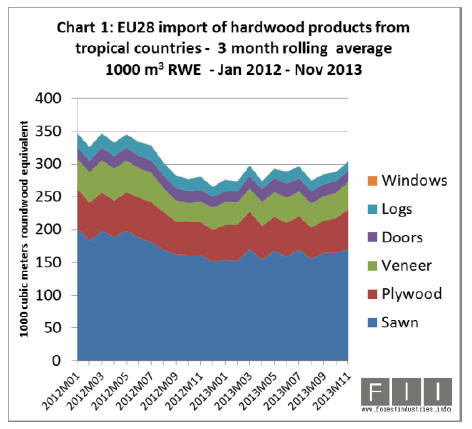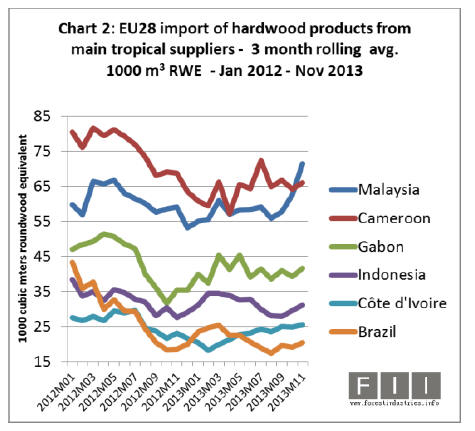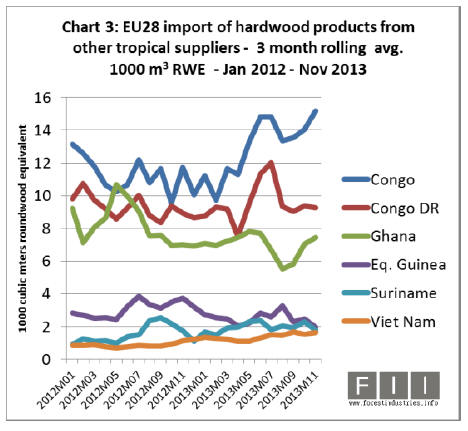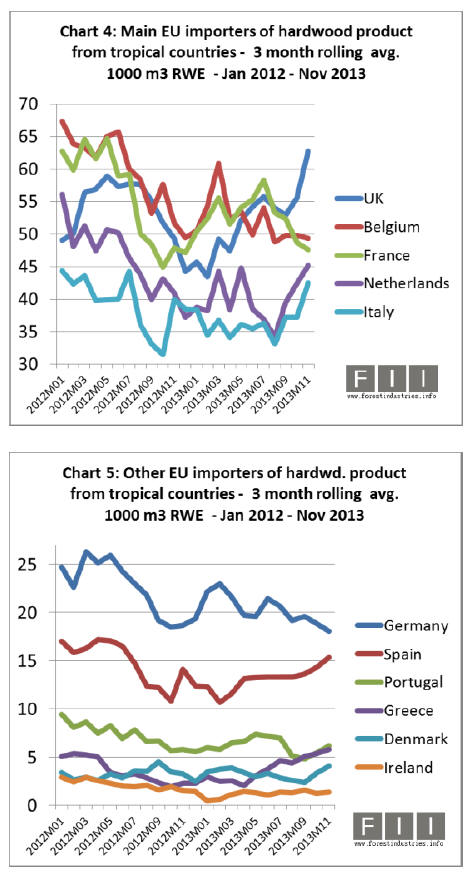|
Report
from
Europe
EU imports of tropical hardwood fall to new lows in
2013
After record lows in 2012, the latest EU trade data
indicates that imports of hardwood products from tropical
countries fell even further during 2013. In the first 11
months of 2013, EU28 imports of sawn hardwood from
tropical countries were 870,200cu.m, 8.2% less than the
same period in 2012.
Imports of tropical hardwood logs were only 170,900cu.m
between January and November 2013, 23.6% less than the
same period in 2012. Direct imports of hardwood plywood
from tropical countries (i.e. excluding imports from China)
declined 4.8% to 1.14 million cu.m during this period.
Tropical hardwood veneer imports fell 7% to
251,500cu.m.
These numbers for the whole of the EU are indicative of
the slow pace of recovery in the European economy,
particularly in the construction and furniture sectors which
are so important for hardwood consumption. They are also
the result of on-going supply problems.
Unlike in previous years when Europe was the dominant
market, European buyers now have much less leverage to
encourage more rapid delivery or prevent diversion to
larger buyers in other parts of the world.
The total numbers for the whole of the EU during 2013
hide significant variations in market conditions between
countries and at different times of the year. Some of these
more subtle variations are apparent in the following series
of charts (Chart 1 to 5).
The charts show the 3-month rolling average roundwood
equivalent (RWE) volume in cubic meters of EU imports
of hardwood products from tropical countries to end
November 2013.
RWE is used so that data for all products may be
aggregated and also to provide a rough measure of the
¡°forest footprint¡± of EU trade1. The moving average is
used to smooth out short-term fluctuations, which are
strongly influenced by factors like vacations or shipping
delays, so that the longer-term trend becomes clearer.
Imports from China are omitted from all the charts to
focus attention on direct trade with tropical countries and
to avoid distortion of data by the large share of nontropical
hardwood (poplar and eucalyptus) in Chinese
products.

Chart 1 highlights that in terms of RWE volume well over
half of EU imports of tropical hardwood products now
arrive in the form of sawn wood, with much of the
remainder consisting of veneer and plywood.
The volume of log imports has diminished to negligible
levels. Despite the recent policy focus on value added in
tropical countries in recent years, in practice only a small
proportion of finished joinery products are imported into
the EU.
The 3 month rolling average of EU imports of hardwood
products from tropical countries fell to a low of
266,000cu.m/month RWE in December 2012 and staged a
slow and hesitant recovery during the course of 2013. By
November 2013, the 3 month rolling average had risen to
304,000cu.m3/month RWE, mainly due to improving
imports of sawn wood and plywood.
1 RWE can only ever provide a ¡°rough measure¡± because
of the numerous assumptions made on conversion
efficiency and waste utilisation. For the sake of
transparency, the RWE figures here have been calculated
based on the following assumed conversion rates: logs
(100%), rough sawn (47.5%), planed/sanded sawn (45%),
veneer (55%), plywood (43.5%), and joinery products
(33%). It‟s also simplistically assumed that no waste
material (e.g. offcuts and saw dust) is used for
manufacture of other wood products (which in practice
would mean some of the RWE volume should be allocated
to these other products).
Supply problems contribute to declining EU imports
from Cameroon
Chart 2 shows how the fortunes of major suppliers of
tropical hardwood to the EU changed throughout the
course of 2013.
Imports from Cameroon, the largest single tropical
hardwood supplier to the EU (mainly of sawnwood), fell
sharply in the nine months prior to February 2013 and
remained at the relatively low average of around
65,000cu.m/month RWE during the rest of 2013.
This trend coincides with mounting supply problems in
Cameroon, particularly of sapele, the most popular
commercial species in Europe.

¡¡
Reports from traders suggest that harvesting in Cameroon
in 2013 was concentrated in less accessible and remote
areas which pushed up transport costs because of the
distances involved.
Logging in the last quarter of the year was further
curtailed by a severe rainy season. The main port at
Douala has suffered a series of problems leading to heavy
congestion from vessels waiting to load and unload.
Problems include faulty cranes, the need for dredging due
to silt build-up, and mounting labour problems which
culminated in a week-long strike by dock workers in
December 2013.
Meanwhile, European buyers have increasingly struggled
to secure tropical hardwood supplies from Cameroon in
the face of strong competition for the same raw materials
from buyers elsewhere, notably China and the United
States.
Falling French consumption hits exports from Gabon
Chart 2 shows that imports from Gabon during 2013 were
impacted both by supply problems and changing
consumption patterns in France where much of the wood
is consumed. Government harvesting restrictions and other
measures contributed to reduced log supply in Gabon
during 2013.
Meanwhile the French economy and construction activity
dipped sharply in the first quarter of 2013 and imports of
Gabonese hardwood fell accordingly. However, French
market conditions stabilised to some extent from the
second quarter of 2013 onwards. EU imports from Gabon
were averaging around 40,000cu.m/month RWE for much
of 2013.
EU imports of tropical hardwood from Cote d‟Ivoire fell
to a low of only 15,000cu.m/month RWE in the three
months to February 2013 as importers grew increasingly
concerned about possible EUTR conformance issues.
However, imports recovered to an average of
25,000cu.m/month RWE in the three months to November
2013 as importers grew more confident that the available
legal documentation would stand up to EUTR scrutiny.
EU imports from Ivory Coast also benefitted from slow
recovery in demand for key species like framire and ayous
in the UK and Italian markets during the second half of
2013.
Recovery in EU imports from Republic of Congo
Chart 3 shows that EU imports of tropical hardwood
products from the Republic of Congo were also recovering
from the second quarter of 2013 onward. EU monthly
imports from the country which were averaging
10,000cu.m at the start of 2013 had risen to 15,000cu.m in
the three months to November 2013.
EU demand for wood from the Republic of Congo has
been boosted by limited availability elsewhere and the
commitment of larger shippers to supply of FSC certified
products.

EU policy measures contribute to sharp rise in imports
from Malaysia
EU tropical hardwood imports from Malaysia hit a low of
53,000cu.m/month RWE at the end of 2012 and remained
at this level until September 2013.
However, EU imports from Malaysia surged during the
autumn months to an average of close to
75,000cu.m/month RWE. The surge is partly due to
improvement in the UK economy and some early signs of
life in the Netherlands construction market.
A range of EU policy measures also contributed to the
rapid increase in imports from Malaysia at the end of
2013. Loss of Malaysia.s preferential status under the EU's
Generalised Scheme of Preferences (GSP) meant that EU
import duties on Malaysian products increased from 3.5%
to 7% on 1 January 2014.
This encouraged importers to restock in advance of the
deadline. Meanwhile the EU Timber Regulation has given
Malaysian plywood shippers a competitive boost relative
to Chinese manufacturers that have struggled to meet new
demands for legal documentation.
The EU.s Construction Products Regulation has also
benefitted Malaysian shippers of higher quality plywood
products able to meet new technical performance
standards.
Only limited tropical hardwood imports from Brazil
EU imports of tropical hardwood from South America
have fallen dramatically since the start of the recession.
EU monthly imports of all tropical hardwood products
from Brazil were averaging no more than
20,000cu.m/month RWE by the end of last year.
However Suriname is one South American country that
has bucked the trend, with EU imports from the country
rising consistently over the last 2 years, albeit from a small
base.
This is due to recent investment in processing facilities in
Suriname combined with a commitment to FSC
certification by at least one leading operator which has
encouraged greater interest from European buyers,
particularly in the Netherlands.
Strong rebound in UK tropical hardwood imports
Charts 4 and 5 show how imports of tropical hardwood
into the main EU markets have progressed over the last
two years. Imports fell sharply throughout the EU during
the prolonged winter in late 2012 and early 2013 when
European construction activity reached an all-time low.
Since then market conditions have diverged widely
between countries.
Imports into the UK have rebounded so strongly that, by
the end of 2013, the country had emerged as the largest
single EU importer of tropical hardwood products. Imports
into France recovered well until August 2013 but then fell
sharply in the autumn months.
Imports into Belgium spiked in March 2013, but then
declined progressively throughout the rest of the year. The
closure of DLH.s stock-holding operation in Belgium
during 2013 may well have been a factor in this decline.
After a long period of recession, the Dutch market and
several Southern European markets including Italy, Spain
and Greece, were showing signs of recovery at the end of
2013.
Imports into Portugal continued to decline throughout
2013, very much in line with construction sector activity
in the country which was weakening last year.
There are also indications that joinery manufacturers in
Portugal are shifting away from tropical hardwoods in
favour of temperate species.
The same trend is apparent in Germany, the largest single
consumer of wood products in the EU, where tropical
wood imports were low and declining during 2013.

Lacklustre EU demand in 2014
There is unlikely to be any significant upturn in EU
tropical hardwood trade in 2014. The continued sluggish
pace of economic and construction activity and the low
level of supply are likely to act as a significant brake on
trade.
The latest European Commission forecast is for 1.4% GDP
growth across the EU during 2014, only a slight
improvement on the 0% growth projected for 2013.
Euroconstruct, an independent research agency, is
forecasting growth in European construction output of no
more than 0.9% in 2014 and 1.8% in 2015.
Meanwhile, delivery times into the EU for key tropical
hardwood products remain very lengthy. Delivery times
for wood species from the Congo region are now up to 6
months. Delivery of standard specifications of sawn wawa
from Ghana and sawn meranti from Malaysia are up to
three months.
Strong demand for African sapele sawn wood is driving
price rises to levels that European importers often find
difficult to pass on to their customers. Importers report
that FOB prices for FAS AD 52mm sapele lumber in
standard lengths and widths now stand at between
€650/cu.m and €680/cu.m, up from closer to €600 in mid-
2013.
These prices are not far short of those for sipo which have
remained more stable at around €700/cu.m fob for non
FSC-certified goods and up to €770/cu.m for FSC
certified.
Prices for other key African wood species in the European
market have been relatively more stable than those for
sapele, but where there is movement it tends to be
upwards.
The FOB price for FAS AD 52 mm iroko sawn wood
increased by around €30/cu.m in 2013 and now stands at
around €650-700/cu.m fob for air dried and €750-
800/cu.m for kiln dried. The FOB price for framire sawn
wood is in the region of €500/cu.m fob. Wawa No. 1 c+s
is selling for around €350/cu.m fob. Prices for Khaya sawn
wood have been firming on the back of good US demand.
At this time of year, European importers would normally
be stocking up large volumes of tropical hardwood
decking profiles in preparation for the spring garden
season.
However, orders so far this year have been quite limited
with many importers adopting a wait-and-see approach
until there is clearer information about the volume of
stocks left over from last season. Weak consumption in
2013 has meant there is a stock overhang. Uncertainty has
also been created by several high-profile closures of
distribution operations in Belgium and Netherlands.
But, there are some more positive indications emerging
from the decking sector. Unlike last year, the winter so far
in 2014 has been warm and mild which is encouraging a
few merchants to consider earlier deliveries this year. This
trend is being boosted by more competitive pricing for
bangkirai decking profiles.
Prices for delivery „standard and better. grade bangkirai
into Northern Europe currently stand at around
$1500/cu.m, down from prices of up to $1800/cu.m a
couple of years ago. Bangkirai decking can also still be
obtained within around five weeks. However, analysts
suggest, both prices and delivery times could increase
quite quickly if demand does pick up.
* The market information above has been generously provided by the
Chinese Forest Products Index Mechanism (FPI)
¡¡
|